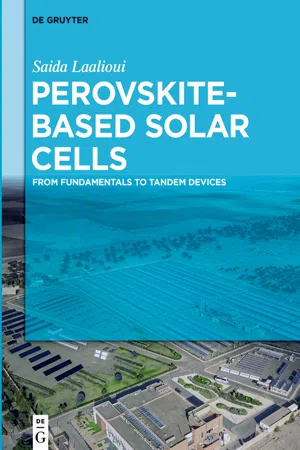
- 93 pages
- English
- ePUB (mobile friendly)
- Available on iOS & Android
About this book
"Perovskite-Based Solar Cells: From Fundamentals to Tandem Devices" gives fundamental understanding of perovskite solar cells from the chemical composition of each thin layer composing the different stacks to the whole device. Special attention has been given to the development of the materials forming the perovskite solar cell and their effect on the device performance, in addition to the recent progress of this emerging technology. Moreover, light has been shed on the perovskite elaboration techniques, in addition to the several techniques proposed to improve both the efficiency and the stability of perovskite solar cells. Furthermore, special emphasis was given to the three types of tandem solar cells and their recent advances starting from Perovskite/perovskite tandem solar cells to Perovskite/ CIGS tandem cells to perovskite/ heterojunction silicon tandem solar cells. The latter constitute a promising solution to improve photovoltaic solar cells performance.
Frequently asked questions
- Essential is ideal for learners and professionals who enjoy exploring a wide range of subjects. Access the Essential Library with 800,000+ trusted titles and best-sellers across business, personal growth, and the humanities. Includes unlimited reading time and Standard Read Aloud voice.
- Complete: Perfect for advanced learners and researchers needing full, unrestricted access. Unlock 1.4M+ books across hundreds of subjects, including academic and specialized titles. The Complete Plan also includes advanced features like Premium Read Aloud and Research Assistant.
Please note we cannot support devices running on iOS 13 and Android 7 or earlier. Learn more about using the app.
Information
Chapter 1 Perovskite-based solar cells
1 Introduction
2 Perovskites
3 Crystal structure of the hybrid perovskite



4 Characteristics of perovskites
- Absorption of wavelengths up to 800 nm as shown in Figure 2 [7, 11, 12]
- A direct bandgap between 1.30 and 2.23 eV [4, 7, 11, 13]
- Possibility of adjusting their optical bandgaps by an appropriate selection of mixed cations and halides as shown in Figure 3 [7, 12]
- Good separation of electrical charges, which explains their high open-circuit voltages (Voc) up to 1.31 V [14]. Indeed, thanks to the spontaneous electric polarization of the perovskites, internal electric fields are induced, which makes it possible to separate the photoexcited charge carriers, while reducing their recombination [7].
- High charge-carrier mobilities, of the order of 7.5 cm2/Vs for the holes and 12.5 cm2/Vs for electrons, measured at terahertz THZ frequencies [7]
- Good light absorption, which explains the high short-circuit current density (Jsc) values, up to 23 mA/cm2 [7]
- Lar...
Table of contents
- Title Page
- Copyright
- Contents
- Abbreviations list
- General introduction
- Chapter 1 Perovskite-based solar cells
- Chapter 2 Perovskite solar cell fabrication methods
- Chapter 3 Perovskite-based tandem solar cells
- Chapter 4 Perovskite/silicon heterojunction tandem solar cells
- General conclusion
- Index